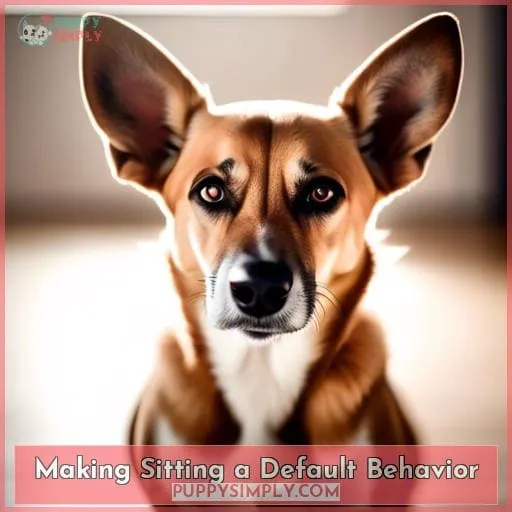This site is supported by our readers. We may earn a commission, at no cost to you, if you purchase through links.
 Did you know that teaching your dog to sit is one of the most important commands you can teach them?
Did you know that teaching your dog to sit is one of the most important commands you can teach them?
It’s a fundamental behavior that opens the door to more advanced training and makes living with your dog easier and more enjoyable.
In this step-by-step guide, we’ll walk you through the process of teaching your dog to sit, from the initial luring and rewarding to fading out the treats and adding a verbal cue.
Let’s get started!
Table Of Contents
- Key Takeaways
- Benefits of Teaching a Dog to Sit
- Step-by-Step Guide to Teach a Dog to Sit
- Adding the Cue Word ‘Sit
- Making Sitting a Default Behavior
- Ending the Training Session
- Frequently Asked Questions (FAQs)
- How do I maintain control over my dog during training sessions?
- How can I overcome challenges if my dog struggles to understand the concept of sitting?
- What are some common mistakes to avoid while training my dog to sit?
- How can I keep my dog engaged and motivated throughout the training process?
- Are there any specific treats or rewards that are particularly effective in training dogs to sit?
- Conclusion
Key Takeaways
- Teaching a dog to sit has numerous benefits, including increased obedience, safer road crossing, prevention of jumping on people, and a stronger bond between dog and owner.
- The step-by-step guide to teaching a dog to sit involves using a treat to lure the dog into a sit position, praising and rewarding the dog when they sit, adding the cue word sit, and making sitting a default behavior.
- Ending the training session on a positive note with an okay cue, praise, and a treat is important for the dog’s motivation and engagement.
- Common mistakes to avoid include forcing the dog into position, using harsh corrections, expecting instant results, and not keeping the dog engaged and motivated.
Benefits of Teaching a Dog to Sit
Teaching your dog to sit has many benefits:
- It can make crossing roads safer.
- It can help prevent them from jumping on people.
- It can improve their overall obedience.
- Plus, it’s a great way to strengthen the bond between you and your furry friend.
Safer Road Crossing
You’ll teach your dog to sit frequently.
This will keep it safe while crossing the road.
A dog that knows how to sit can be more easily controlled.
This makes it less likely to dart into traffic.
This simple command can save your dog’s life.
Prevents Jumping on People
By teaching your dog to sit, you can prevent them from jumping on people, creating a safer and more controlled environment.
Manners Training:
Sitting is a basic command that teaches your dog manners and respect for personal space.
Behavioral Etiquette:
A dog that knows how to sit can behave politely in social situations, reducing the risk of accidents or injuries.
Socializing Puppies:
Teaching your puppy to sit early on helps them learn how to interact appropriately with people and other animals.
Positive Reinforcement:
Rewarding your dog for sitting reinforces good behavior and strengthens your bond.
Canine Courtesy:
A dog that sits when greeted shows respect and prevents unwanted jumping, making them more pleasant to be around.
Improves Obedience
Teaching your dog to sit will help you gain more control over its behavior, making training and obedience easier.
Consistency is key here—the more you practice, the better your dog will understand what you want.
As your dog masters the sit command, you can move on to more advanced obedience milestones, strengthening your bond and opening up real-life applications like safer road crossings and preventing jumping on people.
Strengthens Bond Between Dog and Owner
A dog and owner that train together establish a stronger bond and deeper understanding of each other’s needs.
Interactive Training:
- Training your dog to sit involves interactive play, building activities, and training challenges that strengthen your bond.
Communication Exercises:
- Teaching your dog to sit improves communication, as you learn to understand each other’s body language and vocal cues.
Outdoor Adventures:
- Taking your dog on outdoor adventures, like hikes or walks, while practicing the sit command reinforces your bond.
Sit Pretty Trick:
- Teaching your dog the sit pretty trick adds an element of fun and shows off your dog’s intelligence, impressing friends and family.
Useful for Various Situations
So, you can teach your dog to sit. This will help it behave obediently in different situations, like greeting guests or waiting patiently at the vet’s office. Mastering this fundamental command opens up a world of possibilities for you and your furry friend.
Outdoor Applications:
- Safer road crossing
- Waiting at the park
- Canine Etiquette
- Sit-stay at restaurants
-
Polite leash walking
Home Behavior:
- Prevents jumping on people
- Calming down before meals
-
Accepting petting from strangers
Social Interaction:
- Polite greetings
- Sit-stay during emergencies
- Strengthens your bond
- Useful for various situations
Step-by-Step Guide to Teach a Dog to Sit
Your first step is to hold a tasty treat near your dog’s nose and move it in an arc over their head.
Your dog will naturally follow the treat with their head and sit down.
When they do, immediately praise them and give them the treat.
Holding a Treat Near the Dog’s Nose
Holding a small, tasty treat near your dog’s nose will entice them to follow its movement.
Keep the treat close to their nose, but not so close that they can snatch it away.
Use a treat that your dog loves and is willing to work for.
The aroma and taste of the treat will help build focus and create positive associations with the training exercise.
Start with short sessions and gradually increase the duration as your dog progresses.
Patience and consistency are key to successful training.
Moving the Treat in an Arc Over the Dog’s Head
How then do you move the treat in an arc over your dog’s head to encourage it to sit?
With the treat in hand, place it near your dog’s nose.
Then, in one smooth motion, draw an arc with the treat, starting from your dog’s nose and moving it over its head in a backward direction.
Use precision timing, ensuring the treat moves just above your dog’s head, not too high or too low.
This arc technique, combined with effective communication and proper treat placement, will encourage your dog to follow the treat, naturally transitioning into a sitting position.
Praising and Rewarding the Dog
After moving the treat over your dog’s head, immediately praise and give them a small, tasty treat to reinforce their sitting position.
Praise is crucial for positive reinforcement, as it lets your dog know they’ve done something right.
Rewards strengthen the bond between you and your dog, making training more enjoyable for both of you.
Consistency in training is key, so always praise and reward your dog when they sit, helping them understand what you expect of them.
Repeating in Short, Regular Sessions
To make sure your dog learns to sit consistently, repeat the steps in short, regular sessions throughout the day.
Start with a few repetitions in each session, and gradually increase the number as your dog gets the hang of it.
Keep the sessions short and sweet to maintain your dog’s focus and motivation.
Consistency is key, so make sure to practice in different locations and situations to reinforce the behavior.
Adding the Cue Word ‘Sit
To add the cue word “sit,” say it just as your dog starts to move into position.
Do not say it before they begin to sit, or they may become confused.
Use the cue word consistently, and always pair it with positive reinforcement, such as a treat or praise.
Timing of the Cue Word
Once your dog reliably sits when you entice them with a treat, start saying sit as they move into position.
Say it calmly and clearly, right before they fully sit.
Consistency is key – always use the same word or phrase for sitting.
Vary your rewards to keep training interesting and fun, and don’t forget to praise your dog enthusiastically for a job well done.
This strengthens your bond and motivates them to learn.
Consistency With the Cue Word
With the timing of your cue word down, consistency is key in teaching your dog to associate the word sit with the action of sitting.
Consistent Commands:
- Use the cue word sit every time you want your dog to sit.
- Never use other words or phrases, as this will confuse your dog.
Timely Reinforcement:
- Say sit just as your dog starts to sit, not before or after.
- This helps your dog understand that the word sit means to put its bottom on the ground.
Positive Persistence:
- Be patient and persistent with your training.
- It may take some time for your dog to learn, but with consistent commands, timely reinforcement, and positive persistence, you’ll eventually s쳮d.
Use of Positive Reinforcement
Positive reinforcement, like treats and affectionate praise, will help you effectively teach your dog the meaning of the cue word sit.
This method strengthens your bond, encourages training success, and promotes effective communication.
Rewarding techniques create a positive association with the behavior, making training a joyful experience.
Consistent encouragement builds behavioral harmony, while positive reinforcement fosters canine companionship.
Making Sitting a Default Behavior
To make sitting a default behavior:
Reward your dog whenever they sit on their own, whether it’s when they walk over to you or sit while you fill their food dish.
Over time, your dog will start offering sits whenever they want something, knowing they’ll earn a reward.
Rewarding the Dog for Sitting on Their Own
After your dog consistently responds to the cue word sit, start rewarding them whenever they sit on their own initiative.
This reinforces sitting as a desirable behavior and encourages them to do it spontaneously.
Spontaneous sits can happen when your dog greets you, waits for food, or settles down on their own.
Be ready to reward these unprompted sits with treats, praise, or a fun game.
Consistently Rewarding the Dog for Sitting
To make sitting a default behavior, consistently reward your dog whenever they sit on their own.
This positive reinforcement reinforces the behavior and makes it more likely they’ll offer sits in the future.
Be consistent with your rewards, offering treats, praise, or play whenever they sit without prompting.
Over time, sitting will become their go-to behavior when they want something, like attention or a treat.
Ending the Training Session
To end your training session:
Give your dog an “okay” cue to signal the end.
Praise them for their good behavior.
Offer them a treat as a reward.
This will help your dog associate the end of the session with positive reinforcement, making them more likely to cooperate in future training sessions.
Giving an ‘Okay’ Cue
Give your dog a clear Okay signal to let them know the training session is over. This could be a hand gesture, a verbal command, or a clicker.
Use a cheerful tone of voice and positive body language to signal the end of the session.
Avoid using the Okay signal during the training session, as this can confuse your dog.
Reward your dog with a treat or praise after giving the Okay signal to create a positive association.
Gradually increase the length of your training sessions as your dog becomes more comfortable with the Okay signal.
Praising the Dog for Good Behavior
When your dog sits after you give the okay cue, lavish praise upon them with enthusiastic words and a warm, gentle tone.
Positive reinforcement techniques are essential for training consistency.
A cheery Good sit! or Attaboy/girl! reinforces the desired behavior and strengthens your bond.
Ensure your praise is sincere and consistent, creating a positive interaction that encourages behavioral consistency.
Offering a Treat as a Reward
After praising your dog’s good behavior, offer it a tasty treat as a reward.
Using treats as positive reinforcement boosts training success and strengthens your bond.
Treats motivate dogs, making them more receptive to learning.
Offer the treat immediately after the desired behavior to create a strong association between obedience and sweet incentives.
This effective technique enhances your dog’s motivation and makes training sessions more enjoyable.
Ending the Session on a Positive Note
- To conclude the training session on a positive note, give your dog an okay cue.
- This signals the end of training and helps your dog associate sitting with a rewarding finale.
- Use a consistent cue word like okay or all done so your dog learns to recognize when the session is over.
- Praise your dog enthusiastically for good behavior and offer a small treat as a final reward.
- Always end the session on a happy note, leaving your dog with positive associations and a desire to continue training in the future.
Frequently Asked Questions (FAQs)
How do I maintain control over my dog during training sessions?
Maintain control during training sessions by:
- Keeping a firm grip on the leash, preventing your dog from wandering or becoming distracted.
- Ensuring their focus remains on you and the training task at hand, promoting effective learning.
How can I overcome challenges if my dog struggles to understand the concept of sitting?
Imagine your furry companion, eager to please, yet struggling to grasp the concept of sitting.
With patience and empathy, break down the process into smaller steps, using positive reinforcement and gentle guidance.
Together, you’ll overcome this hurdle, strengthening your bond and achieving training success.
What are some common mistakes to avoid while training my dog to sit?
Avoid these common pitfalls:
- Forcing your dog into position.
- Using harsh corrections.
- Expecting instant results.
Patience, positive reinforcement, and consistency are key to successful training.
How can I keep my dog engaged and motivated throughout the training process?
Keep training sessions short and frequent to maintain your dog’s focus.
Vary the training location.
Incorporate play and games to make the process enjoyable and engaging.
Are there any specific treats or rewards that are particularly effective in training dogs to sit?
Discover delectable rewards that entice your dog’s taste buds and accelerate their learning journey.
Experiment with savory treats, aromatic chews, or even their favorite toys to keep training sessions exciting and rewarding.
Conclusion
Picture this: you and your dog, strolling through the park, the sun casting a warm glow on both of you.
As you approach a busy road, you give the command Sit. Your dog instantly obeys, patiently waiting for your signal to cross.
The cars whiz by, but your dog remains calm and focused, trusting in your leadership.
This is the power of teaching your dog to sit—a simple command that can make all the difference in your dog’s safety and obedience.
With patience, consistency, and positive reinforcement, you can train your dog to sit, creating a bond that’s unbreakable.











